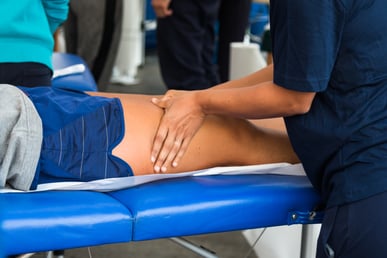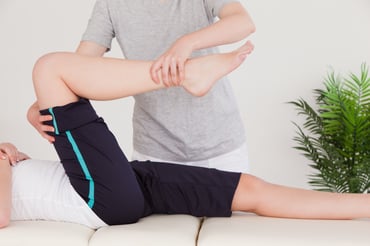Massage therapy has gone from a perceived luxury to a useful and even crucial part of treating ailments from the hospital to the athletic training room. Until the past 10 years, there wasn't conclusive evidence that massage really does have a positive effect on athletes. However, thanks to new studies and some backing by reputable sources, the benefits of massage are being taken seriously. And those benefits are not just for the pros. They’re extended to anyone who participates in a regular exercise program.
 According to the American Massage Therapy Association (AMTA), massage acts to improve performance, reduce pain, prevent injury, encourage focus and shorten recovery time. It basically involves two types of responses: a mechanical response as a result of the pressure and movement and a reflex response where the nerves respond to the stimulation of a massage.
According to the American Massage Therapy Association (AMTA), massage acts to improve performance, reduce pain, prevent injury, encourage focus and shorten recovery time. It basically involves two types of responses: a mechanical response as a result of the pressure and movement and a reflex response where the nerves respond to the stimulation of a massage.
Physiological Effect
You may not realize it, but massage affects he cardiovascular system. It dilates blood vessels, which helps them work more efficiently to promote circulation. The manual assistance of encouraging venous blood flow back to the heart enhances blood flow, which delivers fresh oxygen and nutrients to the tissue and promotes the removal of waste products and toxins. Thanks to the relaxed state you’re in during and after the massage, your heart rate lowers.
More known and expected are the benefits of massage to the muscular system. One of them directly ties to the cardiovascular benefits. The increased and enhanced blood circulation helps to relieve muscle tension, reduce soreness and make for a faster recovery. Then the relaxed muscles can experience “an increase in range of motion and flexibility,” as explained in a study in the Journal of Sports Medicine and Physical Fitness. Both of those benefits can lead to better athletic performance. In short, massage can help pain relief, build muscles and encourage their recovery as well. Not only does massage feel good on the muscle tissues, it actually is good for them.
Psychological Effects
The sports massage study in the Journal of Sports Medicine and Physical Fitness points out that athleticism, particularly the athleticism required in competitive sports, doesn’t rely solely on physical strength. Tactical maneuvering in cycling or an ability to focus on a task (e.g., gymnastics or golf) can also affect performance. Therefore, the psychological effect provided to an athlete by an experience such as massage may be of importance in a non-physiological manner. These benefits include reducing stress and tension and anxiety while promoting relaxation by activating your parasympathetic nervous system. So you get an increase in dopamine and serotonin levels and a reduction in cortisol levels, which are directly linked to stress. That relaxed, lowered-tension state encourages focus, a good thing to have before going into any sport, group exercise class or competition.
Types Of Massage For Athletes
As an exerciser or an athlete, you’ll benefit more from a deep tissue or sports massage than you will a spa soft-and-gentle-and-smelling-good massage. However, these types of massage may not always be comfortable.
A sports massage often involves a fast-paced massage, stretching and other approaches, depending upon the sport in which you participate. It can be tailored to be used as a pre-workout stretch and opportunity to warm up the muscles or used as a post-workout massage designed to reduce soreness and increase flexibility.
The deep tissue massage often is suggested by massage therapists because it works on particular issues you may have, applying heavier pressure on layers of muscles and other deep tissues. Don’t expect to be comfortable throughout this massage. It’s designed to get into knots and tension the muscles may be holding. But be prepared. With their attention to soft tissue aches and pains, either type of massage can leave you feeling sore.
When To Schedule A Massage
It’s important to note that therapists and research suggest that a massage here and there
is nice, but won’t give you the same benefits as a regular massage program. Like exercise itself, your benefits are cumulative, meaning the more regularly you receive a massage, the more you’ll reap their advantages. Think of it as preventative maintenance. That being said, know that the benefits are often short-lived and part of the reason why it is a cumulative action. Massage therapist Paul Valentine recommends scheduling “once a week if possible or every other week if you’re training at a high level”. If getting a weekly or bi-weekly massage isn’t in the budget or you don’t have time, he suggests aiming for twice a month.
Remembering that you may leave a massage feeling as sore as you would after a tough workout, you’ll want to schedule pre-event (like a hard workout or a long run) or pre-race massages about three to five days before the actual event. In fact, if you can schedule it on a rest day, do so. 
Post-event or post-race massages follow the same rule of thumb: wait three to five days afterwards in order for any lingering soreness to dissipate. “Post-event massage could carry over into the next day or within 72 hours of the event,” said Simon.
The lighter, spa-type of post-race massages either in the tent at the finish line or scheduled for the next day are different. Those lighter massages will simply encourage blood flow and help you to relax and should be taken advantage of if possible.
Pros and amateurs alike who are looking to improve their conditioning and performance, recover faster and with fewer, if any, injuries, should do some research into participating in a regular massage program. While the program may require some financial readjusting to stay within your budget, it seems to be worth the effort. And don’t forget the water! Craig Simon believes that no matter the type of massage or when you receive it, you need to drink half of an ounce of water per pound of body weight for that day. “This is a good formula to follow, even if you aren’t competing,” he said.
Be sure to seek out a licensed massage therapist who has the “LMT” after his or her name and the license number posted on any marketing materials or information. The best way to find a qualified therapist is by asking others who participate in your sport or activity. Word-of-mouth recommendations are excellent referrals usually.
Used as preventative maintenance or to address pain or to assist in recovery, massages can be an essential weapon in your training arsenal. They also help you to relax and feel physically and psychologically better, benefits that even the non-athlete would enjoy.
The AMTA states that research shows that in relation to exercise and athletic participation, massage can do the following: Reduce muscle tension, help athletes monitor muscle tone, promote relaxation, increase range of motion, decrease muscle stiffness and soreness after exercise, enhance athletic performance and help prevent injuries when massage is received regularly.
This blog was curated from an article written by Kerrie Ann Frey for Health & Fitness Magazine. The original article appeared here.

Custom Craftworks
Originally founded in 1986, Custom Craftworks supports the vital work of professional manual therapists and educators in the massage therapy and holistic health fields by designing, building and sourcing the best-quality massage tables, chairs, equipment and accessories available. In 2009, the company was acquired by Pivotal Health Solutions based in Watertown, South Dakota.



